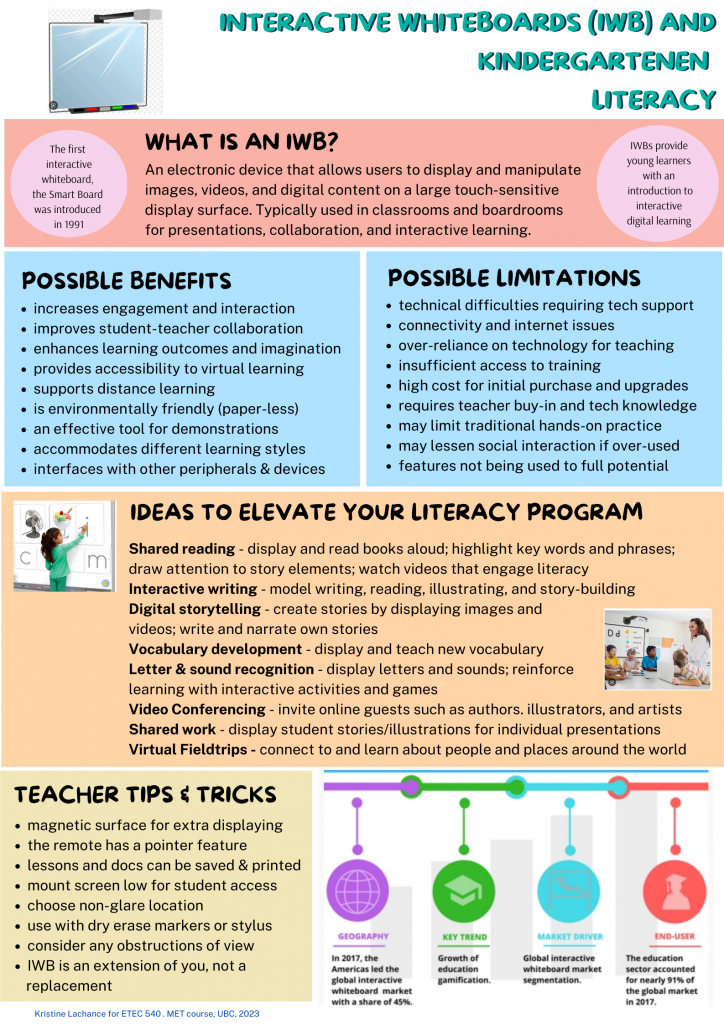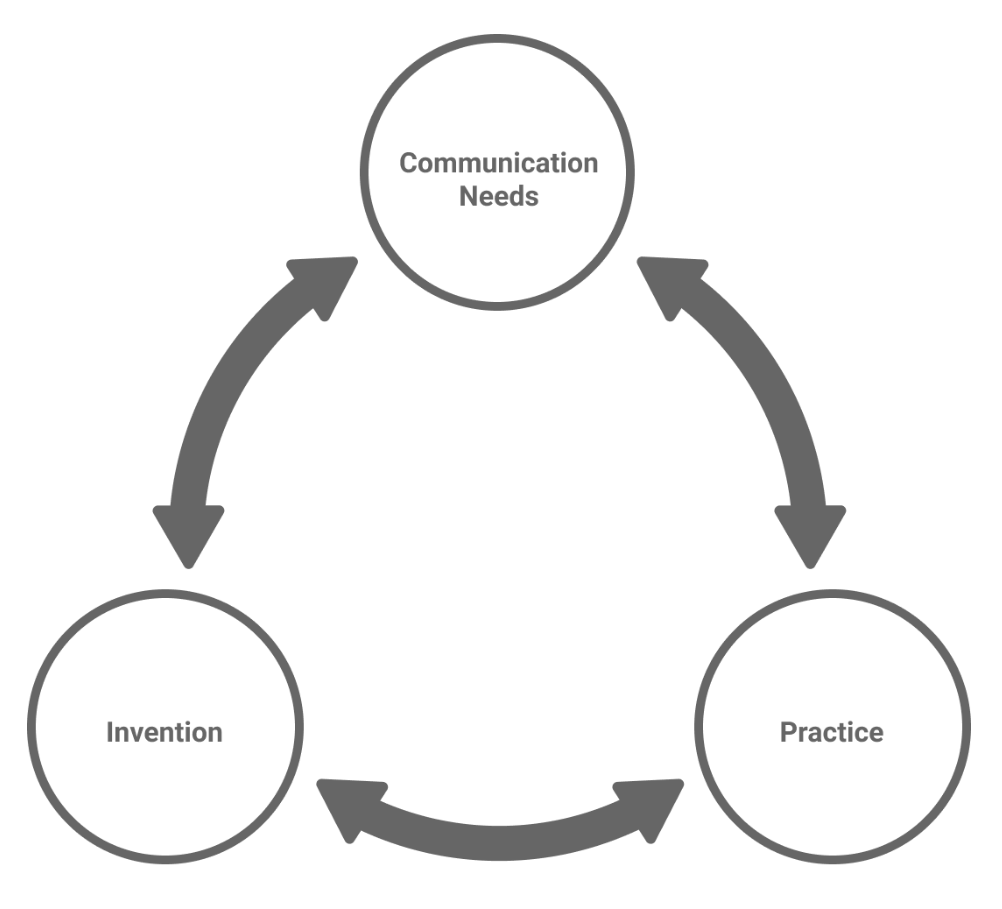Assignment Criteria: Taking the notion of reciprocal relationships between communication needs, invention, and practices as a scaffold, extensively research a particular development in technologies for writing and reading and the implications it had on literacy and education.
Final Assignment:
I chose to design an Infographic Poster to describe the use of IWBs (interactive whiteboards) for literacy programming in a Kindergarten classroom. References are below the poster. An assignment reflection is also included below the references.
________________________________________________________________________

________________________________________________________________________
References:
Bebell, D., & O’Dwyer, L. M. (2010). Educational outcomes and research from 1:1 computing settings. Journal of Technology, Learning, and Assessment, 9(1).
BECTA. (2006). Emerging technologies for learning. Volume 1. Coventry, UK: British Educational Communications and Technology Agency.
Burns, M. K. (2010). Interactive whiteboards: Fostering literacy in the primary grades. The Reading Teacher, 63(4), 298-308.
Cox, J. (October 6, 2019). Technology in the classroom: the benefits of smart boards. Retrieved from https://www.teachhub.com/technology-in-the-classroom/2019/10/technology-in-the-classroom-the-benefits-of-smart-boards/
He, W., Cao, J., Liu, L., & Li, Y. (2017). The impact of interactive whiteboards on student learning: A meta-analysis and research synthesis. Educational Research Review, 22, 74–88.
Hutchinson, N., & Woodward, L. (2014). Interactive whiteboards: Enhancing early literacy in prekindergarten and kindergarten classrooms. Early Childhood Education Journal, 42(3), 171-178.
Klein, F., Specht, M., & Sievering, M. (2019). Virtual and augmented reality in education. International Journal of Computer Science Education in Schools, 2(2), 1-14.
Morgan, H. (2016). A case study exploring the use of interactive whiteboards for literacy instruction in the early years of schooling. Australasian Journal of Early Childhood, 41(1), 28-36.
Technavio. (March 2, 2018). Top factors driving the global interactive whiteboard market. Retrieved from https://www.businesswire.com/news/home/20180302005483/en/Top-Factors-Driving-the-Global-Interactive-Whiteboard-Market-Technavio
Yang, H. H., Huang, Y. M., & Yang, S. J. H. (2020). Artificial intelligence in education: A review of current and future trends. Educational Technology & Society, 23(3), 47-63.
Reflection:

From our ETEC studies, I see the interactive whiteboard as one example of a culmination of inventions which were created for the purpose of human communication and interaction. Communication and writing tools invented through millennia, including the inventions of computers and internet, helped shape and develop communication tools like IWBs.
Prior to the advancements of the internet and digital media, reading and writing were solitary activities. Reading involved books and printed texts while writing typically involved pen and paper or a typewriter. Through technology, literacy has become a more social, interactive, and collaborative activity. Technology has opened up communication, provided access to a wide range of sources, and has broadened the scope of available knowledge.
The reciprocal model discussed in ETEC 540 course demonstrates the relationship between the three areas (communication needs, invention, and practice) in which they work together to bring about change and innovation to the way humans connect.
IWBs have prompted new ways forms of communication, sharing, and collaboration in classroom education. I use an IWB in my Kindergarten classroom on a daily basis. I’ve had the benefit of its use for the past four years. The board is an extension of my teaching. For me, it supports a more streamlined approach to teaching a variety of subjects, including reading and writing literacy.
For me, there are three main limitations that I’ve observed in my school that tend to be sticking points:
- To date, I’ve received no IWB training despite several requests from myself and my colleagues. This lack of training discourages teachers from its use because it appears to have a large learning curve. Without the training, many teachers don’t see the potential it can bring.
- Concerns about internet connectivity and technical difficulties can be stressful when relying on the IWB to work when you need it.
- Teachers-on-call (TOCs) do not have access to your materials. Since your documents are typically created and saved on your own laptop, TOCs cannot fully teach with the IWB. This means lessons need to be revised.
Future of Interactive Whiteboards
Although IWBs are a relatively new technology, there is evidence that they are an effective tool and have a place in the future. A recent online article stated, “The global interactive whiteboard market size was valued at 4.56 USD billion in 2021 and is expected to expand at a compound annual growth rate (CAGR) of 7.45% from 2022 to 2030 and reach around 8.72 USD billion” (Straits Research, 2022). The article points to the future of IWBs with companies’ focus on innovation being the path to providing “diversity and new product features… As a result, several businesses are focusing on integrating AI into IWBs to enhance user demand” (2022).
Reference:
Straits Research. (August 10, 2022). Interactive whiteboard market size is projected to reach USD 8.72 billion by 2030, growing at a CAGR of 7.45%. Retrieved from https://www.globenewswire.com/en/news-release/2022/08/10/2496047/0/en/Interactive-Whiteboard-Market-Size-is-projected-to-reach-USD-8-72-Billion-by-2030-growing-at-a-CAGR-of-7-45-Straits-Research.html